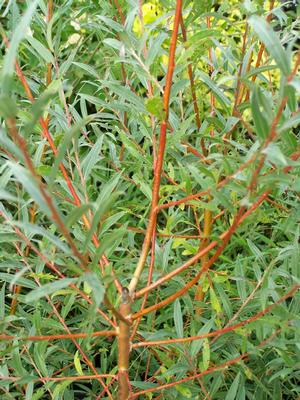Lawns Part IV: Lawn Alternatives - Groundcovers for Wet Sites
GROUNDCOVERS CAN CUT LAWN MAINTENANCE
In part IV of the Lawn and Groundcover series we emerge from the shady sections of your properties to explore lawn alternatives in sun. Perhaps you harbor some very wet sections on your property upon which grasses grow weakly or not at all. This situation may dictate other options. “Rain gardens” can be planted where water has been diverted from roof eaves to a chosen ground.
One possibility in a wet sunny spot is to install drainage tiles under the sod that divert water. But if lawn is not essential an easier sensible fix might be to cluster sun and moisture-tolerant perennials or shrubs that will flourish in wet soils; many species of willows will thrive. Most willows grow large but can be cut down every couple of years to 1 to 2 feet in late winter with loppers or a chain saw. They will soon mushroom like rising bread in spring. Also, better foliage colors are demonstrated on younger wood as in the case of the variegated Salix integra ‘Hakuro-nishiki’ or the improved selection, ‘Flamingo’. Salix alba ‘Britzensis’ (see pic 1) has stunning winter presence with brassy gold old wood topped with tawny crimson new twigs. ‘Scarlet Curls’ displays the same winter colors but on a large shrub or tree with striking contorted wood.
Buttonbush (Cephalathus occidentalis - see pic 2) is a distinctive, native underused shrub that is content in moist to quite swampy conditions. The perfect white globe-shaped flowers commencing in July and continuing into August are a magnet for butterflies. It will grow 3 to 8 feet tall by up to 6 feet wide and can be clustered into a colony or could be used with willows if a richer, more dynamic planting is desired. This shrub may also be pruned back severely as the flowers emerge from new wood. Foliage sometimes develops a respectable yellow color in autumn but this is not a guaranteed annual event.
Most of the shrubby “Alders” (Alnus sp.) like their roots damp to wet. Though less than refined the thicket-forming Alders will thrive in harsh environments where other species would languish. They revel in nutrient poor areas. Female Alders produce little “cones” (strobiles - see pic 3) that hang onto the branches through the winter providing modest interest. The males form dangling tassels in spring before the foliage emerges (see pic 4). It is also a good wildlife plant for a number of birds and butterflies.
“Cattails” (Typha sp.) also are very happy in sunny wet spots. Forming attractive seedheads from which is derived the common name, Typha latifolia is an aggressive spreader growing 5 to 7 feet tall. Each round-topped leaf is approximately 5/8 to 3/4 inches wide. Achieving a more modest 4 feet tall is the attractive Typha laxmannii with blades more pointed and growing 3/8 of an inch wide. Typha minima is the smallest grower with fine fescue or rush-like leaves growing to 2 feet topped with fat, squat up to 1.5 inch cattails in summer. All Typha species have a bit of gray in the green of the foliage. Cattails make handsome colonies and will waste no time doing it!
The “Rushes” (Juncus) also are perfectly at home in wet soils. Juncus inflexus forms grayed blue-green leaves, upright and stiff on a plant that looks like an upside down shaving brush. Growing to just under 3 1/2 feet this tough grass relative will thrive in sun or light shade.
“Bullrush” (Scirpus lacustris) grows up to six feet tall in wet soils. Its girth expands rapidly filling an area expeditiously. Each hollow-tubed spire is a rich green except in the cultivar ‘Albescens’ whose creamy white variegation runs vertically up and down the entire length of each blade.
Variegated Prairie Cord Grass (Spartina pectinata ‘Variegata’) with its longitudinal green/gold striping on narrow arching blades forms a relaxed clump from 4 to 6 feet tall. It will happily spread to 6 feet or so in full to part sun in constantly moist soil.
Our native “Blue Flag Iris” (Iris versicolor) grows fans of sword-like leaves 2 1/2 feet tall. The beautiful blue flowers composed of standards (the 3 cupped upright petals) and the falls (the 3 lower relaxed petals) appear in June. Blue Flag can grow in a fair amount of shade as well but better flowering occurs in sun.
In a larger wet area you might consider combinations of woody shrubs and herbaceous material. Constructing a small pond might be justified if the area of concern holds nearly constant water. In this case be sure to check with your town hall for regulations regarding the implementation of man-made ponds.
Look for The Potting Shed next month: in episode V we will look at groundcovers that might replace lawn in drier sunny areas. Stay tuned.
Penned by Wayne Paquette, Winter 2007


